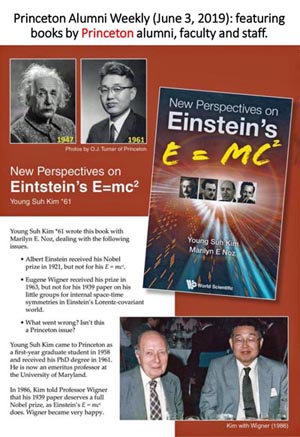Einstein and Wigner, and |
their Nobel Prizes |
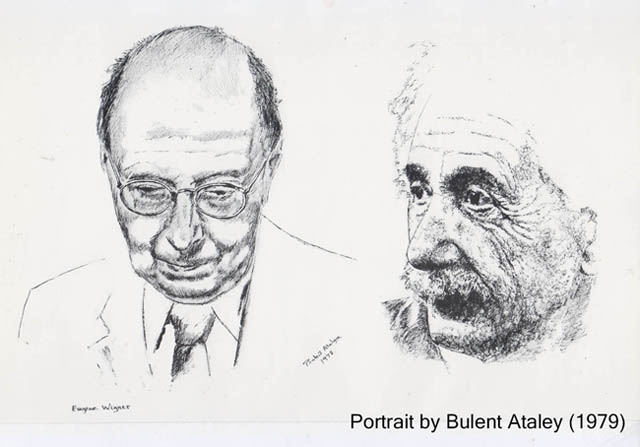
|
- Einstein was very productive in 1905. He completed his theory of
special relativity, and he published his papers on photo-electric effect
and Brownian motions (proving Avogadro's number is a physical number).
In 1921, Einstein received his Nobel prize for his work on the photo-electric effect.
The problem was and still is why the Nobel Committee did not give credits to his formulation of special relativity leading to his E = mc 2. This question is still debated in the physics literature.
- In 1963, Eugene Wigner was awarded the Nobel prize for his contribution
to symmetry problems in physics. Here again, the Nobel Committee did not
give any special credit to his contribution to special relativity, as in the
case of Einstein.
We do not know how the Committee's decision was made, but it is safe to assume that the committee members examined carefully the special issue of the Reviews of Modern Physics dedicated to Eugene Paul Wigner on his 60th Birthday. You may click here for this issue. If your computer cannot reach this journal, you may click here for the cover and contents pages of this issue.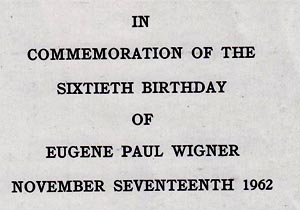
-
from the Reviews of Modern Physics (October 1962).
In this issue, Paul A. M. Dirac is the only author who mentioned Wigner's
1939 paper on the inhomogeneous Lorentz group.
Dirac mentioned this paper in general terms, but he did not discuss Wigner's little groups carrying specific physical interpretations. No other authors in this issue mentioned this paper.
Thus, we cannot blame the Nobel Committee for not mentioning this paper as Wigner's major contribution. Wigner was happy to receive his Nobel prize, but not 100-percent happy because he did not receive the full credit for the paper dearest to his heart.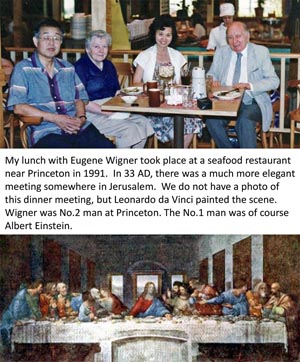
- Many people are wondering how I was able to approach Wigner and
publish papers with him during his late years. The reason is very
simple. I told him Wigner what he really wanted to hear.
I told Wigner that he deserved one full Nobel prize for his
1939 paper on his little groups governing the
internal pace-time symmetries in the Lorentz-covariant world.
I presented to him the following table, which I published in J. Math. Phys. (1986), with my younger colleagues (D. Han and D. Son).
Contents of Einstein's E = mc2 Paricle Variables Massive/Slow between Massless/Fast Einstein
Energy
MomentumE=p2/2m Einstein's
E=(m2 + p2)1/2E= cp Wigner Helicity
Spin, GaugeS3
S1 S2Winner's
Little GroupHelicity Gauge Trans. The extended version of this table was published in Phys. Rev. Letter (1989). You may click here for a detailed exposition of this issue.
There cannot be any disputes on one full Nobel for Einstein's row on the energy-momentum relation in the above table. Likewise, Wigner deserved one full Nobel for his row on the spin-helicity-gauge. This was exactly what Wigner wanted to hear.
- This table made some people very unhappy. Arthur Wightman sent
me a letter telling this table is wrong. Louis Michel became very
angry and wrote a letter to the president of my university to reduce
my position.
Who were Wightman and Michel?
- Arthur Wightman was a professor of physics when I was a graduate
student at Princeton (1958-61), and I learned the Lorentz group in
his class. He took over the Jones professorship after Wigner formally
retired from the University. He liked me and I still like him.
However, he behaved like King Herod
on this issue.
Since he sent me a letter telling me the above table is wrong, he must have told Wigner the same story. Wigner and Wightman had their offices in the same building (Jadwin Hall at Princeton University).
- Louis Michel was the most respected French mathematical physicist,
who also made a major contribution in neutrino physics, known as the
Michel parameters.
I also learned the Wigner stuff from Michel when he gave a series of lectures
at the Univ. of Maryland.
- Wigner thanks both Michel and Wightman in the English version of his
book entitled "Group Theory and Its Applications to the Quantum
Mechanics of Atomic Spectra." Thus, they had enough reason to regard
themselves as the guardians of the Wigner Castle and to get upset
when I approached Wigner without their permission. They were OK. I still
like them. They deserve their
Herod complexes, and I also enjoy my own
Herod complex.
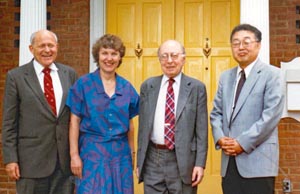
- There were some other characters who attempted to destroy my approach
to Wigner, but they are not worth mentioning. In spite of all those noises,
I enjoyed the full support from John S. Toll, who was the president of my
university at that time. He used to become very happy whenever Wigner came
to his campus at my invitation.
- Who was John S. Toll? He was John A. Wheeler's student at Princeton. From Princeton in 1953, He came directly to the Univ. of Maryland to become the chairman of the physics department. He hired me as an assistant professor in 1962. I was a young man at that time looking like a graduate student. The best thing John Toll did for me was to assign me as a personal servant to Paul A. M. Dirac in 1962 when he visited Maryland for two weeks. Click here to see what I learned from Dirac at that time.
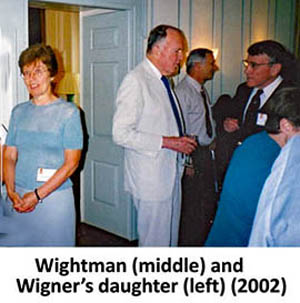
- I must have been close to both Michel and Wightman
because I took these photos with my cameras. They became quite upset
when I approached Wigner directly without their clearance.
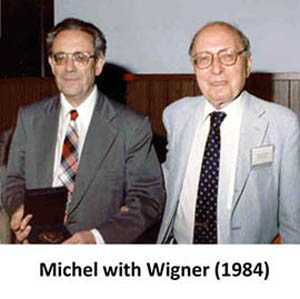
- Arthur Wightman was a professor of physics when I was a graduate
student at Princeton (1958-61), and I learned the Lorentz group in
his class. He took over the Jones professorship after Wigner formally
retired from the University. He liked me and I still like him.
However, he behaved like King Herod
on this issue.
- What comes after the Einstein table given above? Click here more stories.
|
|
- copyright@2015 by Y. S. Kim, unless otherwise specified.
- Click here for his home page.
- His Einstein page.
- His Princeton page.
- His Style page.

I received my PhD degree from Princeton in 1961, seven years after high school graduation in 1954. This means that I did much of the ground work for the degree during my high school years.
